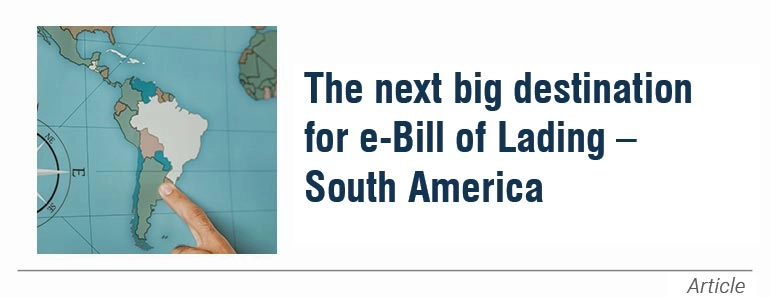
21 Nov The next big destination for e-Bill of Lading — South America

Bill of Lading is a key document in logistics for customs clearance, dispute resolution as well as overall operational efficiency. However, over a period manual bills of lading became the reason for discrepancies and malpractices. To tackle these, industry bodies came up with a digitisation framework and a mandate of making electronic bill of lading the new normal. Digital Container Shipping Association (DCSA) and International Federation of Freight Forwarders Associations (FIATA) have pledged to make bill of lading by the end of 2030.
Globally, Asia Pacific and Europe lead the adoption rate with more than 45 per cent adoption so far. Followed by more than 40 per cent adoption strike rate in North America too is a notable trend. However, the most less penetrated market turns out to be South America, which is far behind the above regions.
Hence, the next big frontier for electronic Bill of Lading is South America. Below we explain why the region is poised for rapid adoption, what the practical benefits will be, and a pragmatic roadmap for carriers, banks, ports and regulators to capture the upside.
Why South America?
South America is emerging as the next major destination for e-Bill of Lading (eBL) adoption, driven by trade scale, regulatory momentum, and digital readiness. The region’s exports—ranging from agricultural commodities and minerals to containerised goods—flow through concentrated port gateways and rely heavily on document-based trade chains such as letters of credit and cargo release instructions. Digitising the Bill of Lading eliminates a key paper bottleneck, accelerating clearance, reducing demurrage risks, and improving overall port efficiency.
Regulatory progress is also supporting this shift. The UNCITRAL Model Law on Electronic Transferable Records (MLETR) has inspired policy discussions across Latin America, with several South American jurisdictions now evaluating or adopting enabling frameworks that offer legal recognition to eBLs. This addresses one of the most significant global barriers to adoption.
Meanwhile, the industry has reached a tipping point in interoperability. Standardised, cross-platform eBL transactions demonstrated in 2025 have shown the feasibility of seamless exchanges among carriers, banks, and customs. With these global standards in place, South America can integrate rapidly into digital trade networks.
Brazil leads this transformation, advancing electronic transport documents and digital trade initiatives. Supported by global eBL vendors and regional collaborations, South America is poised for accelerated, large-scale eBL implementation.
What South America stands to gain?
- Shorter release cycles, lower demurrage and detention costs. Faster electronic presentation eliminates courier delays and reduces time-in-port, which directly lowers visible logistics costs.
- Improved trade resilience. Paperless flows are less affected by air-freight disruptions, consular closures, or travel restrictions — important for time-sensitive agri-exports and seasonal flows.
- Reduced financing friction. Banks and trade financiers can integrate with compliant eBL platforms to speed letter-of-credit workflows and reduce fraud risk through provenance / audit trails.
- Sustainability and reporting. Removing paper aligns with corporate ESG commitments and simplifies emissions accounting tied to cargo throughput and dwell time.
Barriers to adoption
Momentum is real, but adoption won’t be frictionless. There are four persistent issues to manage:
- Legal recognition and enforceability. Not every jurisdiction treats eBLs as equivalent to negotiable paper — that must be fixed through domestic law or clear regulatory guidance.
- Customs and port process integration. Customs authorities and terminal operators must accept eBL-driven workflows for release, gate passes and manifests. That is an operational integration challenge more than a legal one.
- Banking and documentary practices. Trade banks need onboarding plans and legal comfort to accept electronic negotiable documents under letters of credit. That takes pilots and documented precedents.
- Digital divide and SME readiness. Smaller exporters importers need simple, low-friction UX and affordable pricing models to participate — otherwise adoption becomes an enclave of large corporates only.
Success stories in other regions
Breaking all the odds, e-bill of lading has been adopted widely in Asia Pacific, Europe, Africa and North America. Even though the stakeholders were reluctant to adopt, regulators took the initiative ahead and encouraged stakeholders to leverage the advantage.
Due to which, over time the rate of adoption has increased significantly. It has resulted in 70 per cent cost savings, 98 per cent data accuracy and 100 per cent transparency in operations for all stakeholders.
Closing: why acting now matters
Global eBL adoption is still early says surveys and industry reports. While reportedly adoption is rising, it is far from complete. Hence there’s a unique early-mover advantage for regions that coordinate now. South America combines high-volume trade lanes, concentrated port gateways and increasing regulatory engagement with international standards. If stakeholders align around standards-based pilots, legal certainty and bank acceptance, the region can leapfrog inefficient paper chains and capture the economic, resilience and sustainability benefits on a scale that matters. The ingredients are in place; the next year will show whether policy and commerce translate into real, live, cross-border eBL flows through South American ports.
Read more about our Port Community System
